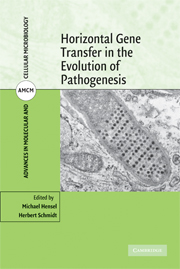Book contents
- Frontmatter
- Contents
- Preface
- Contributors
- PART I Theoretical Considerations on the Evolution of Bacterial Pathogens
- PART II Mobile Genetic Elements in Bacterial Evolution
- PART III Paradigms of Bacterial Evolution
- 6 Genomic Islands in Plant-pathogenic Bacteria
- 7 Prophage Contribution to Salmonella Virulence and Diversity
- 8 Pathogenic Yersinia: Stepwise Gain of Virulence due to Sequential Acquisition of Mobile Genetic Elements
- 9 Genomic or Pathogenicity Islands in Streptococcus pneumoniae
- 10 The Mobile Genetic Elements of Staphylococcus aureus
- 11 Influence of Human Lifestyle on Dissemination of Transferable Elements
- PART IV Interkingdom Transfer and Endosymbiosis
- Index
- References
7 - Prophage Contribution to Salmonella Virulence and Diversity
from PART III - Paradigms of Bacterial Evolution
Published online by Cambridge University Press: 16 September 2009
- Frontmatter
- Contents
- Preface
- Contributors
- PART I Theoretical Considerations on the Evolution of Bacterial Pathogens
- PART II Mobile Genetic Elements in Bacterial Evolution
- PART III Paradigms of Bacterial Evolution
- 6 Genomic Islands in Plant-pathogenic Bacteria
- 7 Prophage Contribution to Salmonella Virulence and Diversity
- 8 Pathogenic Yersinia: Stepwise Gain of Virulence due to Sequential Acquisition of Mobile Genetic Elements
- 9 Genomic or Pathogenicity Islands in Streptococcus pneumoniae
- 10 The Mobile Genetic Elements of Staphylococcus aureus
- 11 Influence of Human Lifestyle on Dissemination of Transferable Elements
- PART IV Interkingdom Transfer and Endosymbiosis
- Index
- References
Summary
INTRODUCTION
Salmonellae are enteric pathogenic bacteria that infect a vast spectrum of animal species from reptiles to mammals. The genus is highly diversified, comprising more than 2,500 serovars. An even greater diversity exists at the strain level as a result of countless combinations of genomic differences in individual isolates. Strain-specific variations are likely to influence aspects of the organism biology, such as the adaptation to specific hosts or environments, the tropism for certain organs or tissues, and the degree of pathogenicity. The emergence in recent years of epidemic clones that have become predominant, displacing pre-existing strains, confirms that strain diversification is an ongoing process. A leading mechanism promoting diversity in Salmonella genomes is lysogenization by temperate phages. Most strains harbor multiple prophages in variable numbers and combinations. Prophages modify the properties of the host bacterium in various ways, from expressing functions that directly influence pathogenicity, to improving the bacterium's ability to outgrow competitors or to resist killing by superinfecting phages. Unlike toxin-producing phages of other bacterial species, most Salmonella prophages contribute to virulence through the synergistic action of multiple factors playing subtle, often redundant roles. The scope of this chapter is to review the various facets of phage-mediated modification of Salmonella, as well as recent advances in the characterization of phage-borne virulence determinants.
SALMONELLA DIVERSITY
Current classification divides the genus Salmonella into two species, Salmonella bongori and Salmonella enterica.
- Type
- Chapter
- Information
- Horizontal Gene Transfer in the Evolution of Pathogenesis , pp. 159 - 192Publisher: Cambridge University PressPrint publication year: 2008
References
- 2
- Cited by

